Relatively easy-to-rank-for keywords that bring in qualified website visitors who are ready to buy.
Magic?
Think again—this is a real thing.
I’m talking about comparison keyword posts.
Specifically, competitor comparison keyword posts.
While most blog content converts into a demo booking from anywhere around 0.10% to 1.50%—these pieces convert like crazy. Here’s a picture of the conversions from one of our client’s comparison keywords:

Yes—that says 100%—but I have to say I saved the best stat for this picture, but on average they convert at 6%, as you can see below, which is still 4x the normal conversion rate.

Not only do they have super high conversion rates, but they’re relatively easy to rank for, if you do them right and get a couple of backlinks.
Today I’m going to walk you through why you should be jumping on this trend and exactly how we’ve done it for our clients so you can do the same.
What are comparison keywords in content marketing?
Comparison keywords are bottom-of-the-funnel keywords that people use when comparing two products or services. It’s when a buyer is shopping for new tech or products and they want to see which one is better for them.
Think about it—I’m sure you’ve Googled or searched on Bing two different products before. Have you ever done that when you weren’t somewhat ready to purchase? Most people have already passed the awareness and consideration stages at this point, and are now knee-deep in decision-stage territory, and I recommend you meet them there.
But comparison keywords aren’t only “Clearscope vs SurferSEO”—there are many forms of comparison, bottom-of-the-funnel keyword searches that will involve you writing about your competitors to some degree:
- [Competitor 1] vs [Competitor 2] vs [your brand] (one cool way to introduce your brand to people who only know your competitor)
- [Your brand] vs [competitor] (provided there is any search volume for your brand already)
- Alternatives to [Competitor] (often a list of tools)
- Best X [product] tools/software (again, a list of tools, but this keyword is a little harder to rank for)
- [Competitor] competitors (can often be grouped with “alternatives to”—but may be searched more by investors and startup aficionados than potential customers)
Why you shouldn’t focus only on high-volume keywords
While these keywords do help generate pipeline and move the needle, there’s something not that sexy about them—they tend to have low search volume.
In fact, that’s what makes them so easy to rank on the first SERP (search engine results page) most of the time. While they do have low search volume (often under 100 monthly searches), they have high purchase intent. People are, at that very moment, looking for a tool to buy. There are many reasons to make sure you own these keywords:
You capture the organic search traffic for people looking to buy a tool like yours
Objections to comparison keyword posts
Initially, a lot of our clients of our B2B SEO agency have objections to creating these pages.
I’m going to address them below.
The main objection we hear all the time is:
Objection 1: “Isn’t it a little too ballsy to not only mention our competitors but even to write a piece about them and potentially introduce our clients to them?”
This isn’t a thought leadership piece that you’re going to announce, distribute and promote.
This is nothing but unadulterated search engine optimized content, friends. Its only purpose is to capture search traffic around these keywords.
Translation: the people who see this page already know about your competitors. They just want to know how other tools are different from them. Be the ones to show them!
Objection 2: “These are such low-volume keywords. Will they help with our goals?”
Okay, nobody has actually shared this objection with me before but I imagine it’s a thought that’s come up. Why try to rank for a keyword with 40 monthly searches?
A few reasons:
- The aforementioned search intent means people using these particular keywords want to buy what you offer.
- You’ll not rank for just one keyword. A lot of these kinds of keywords can be grouped together. To illustrate:
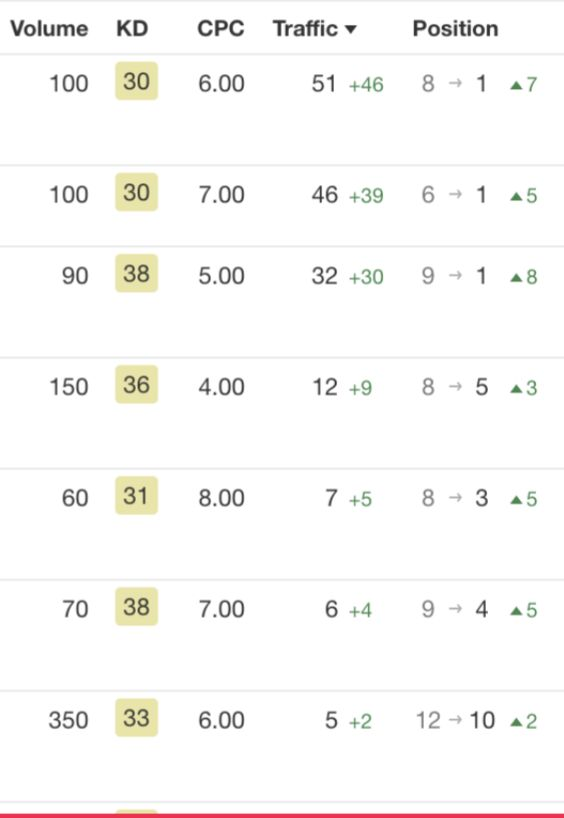

Targeting “one” keyword (in this case, a super high purchase intent one) that has 100 monthly search volume most often means you’ll rank for other variations of that keyword. In this case, we ranked a single page on page one for at least 7 keywords.
You think you’re targeting a keyword for 100 monthly search volume but in the end you get a cumulative 920 monthly searches for a super-high intent keyword.
For this client, this piece resulted in a 131.86% increase in conversion rate.
Objection 3: “Won’t the readers know that we’re biased for our own product?”
Yup.
I don’t think it matters. They are smart people and fully aware they are on your website—and you don’t have to write the piece in 3rd person.
The angle to take is to be objective and use the piece to qualify who is better for your product and who might be better for your competitors. Be honest and talk about how you’re different. Trust me, you’re saving them time.
Objection 4: “Won’t it look petty to trash talk our competitors?”
Yes, it will.
I recommend not trash talking them, instead just highlighting how you are different.
Finding the keywords
Now it’s time to figure out which keywords you should try to rank for. I’ll break this section down into how you can find the keywords, and then figuring out how to format the blog posts so that they’ll actually rank. The latter is a matter of understanding search intent.
Finding comparison keywords in Google Suggest
Google has a great suggest feature that autocompletes a search based on what other people have searched. If you have a well-known brand, you could search for your own brand name:
“[Your brand name] vs” and see what Google suggests.
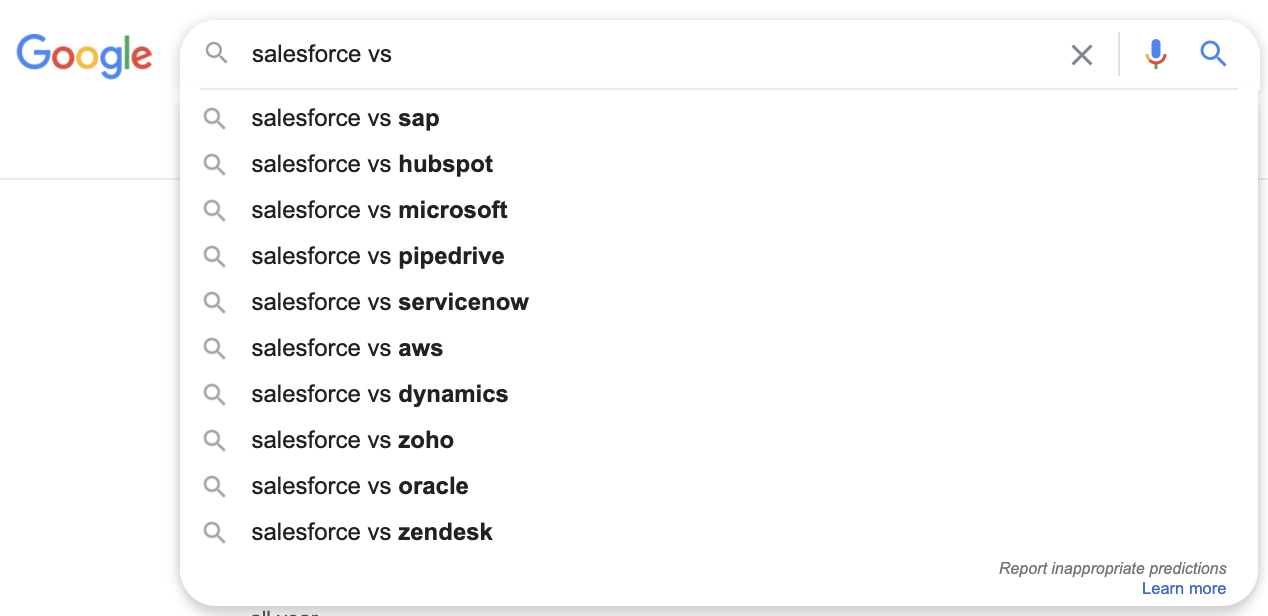

If your brand isn’t that well-known yet, you’ll start by piggybacking off your competitors’ keywords. So you can create pages for all the combinations adding your brand name to the end of it.
While this is a free tool, the downside is that this technique doesn’t give you any search volume. Next, we’ll see how to find these keywords (+ data) in a keyword research tool.
Finding comparison keywords in Ahrefs
Keyword tools like Ahrefs and SEMRush are useful cause they give you more data about the keyword, particularly search volume, keyword difficulty, and parent topic (how many other keywords can you group into this one?).


The only issue is that Ahrefs, like any other keyword research tool, doesn’t always have accurate data. It’ll often say the search volume is super low when you see different data directly from Google.
For instance, if you look at “salesforce vs hubspot” in Google Keyword Planner, you get this:


Not the same as the 300 we saw in the Ahrefs keyword lists.
Plus, Google Suggest will often give you keywords that haven’t even been flagged by Ahrefs yet—it takes them months to find new keywords. But the volume in Google Keyword Planner is a “rounded annual average”, which means it’s not an accurate number either. There’s no consistency in search volume among any tool—not even Google’s own tools.


(Source: Ahrefs)
So why even use an SEO tool? Ahrefs combines data from both Google (which will only show you raw search volume and not other vital metrics like clicks) and Clickstream. Plus, it gives you keyword suggestions. And most of the time, you can rank for a lot of the keyword ideas in a single post. In any case, the data still helps get an idea of search volume and how the keywords can be grouped together.
Anyway, I digress…but I recommend using a combination of Google Suggest and your favorite keyword research tool.
Don’t know where to start?
Outsource your content marketing to a team who does it right.
Understanding the search intent of comparison pages
Search intent is key to be able to rank.
For most pure comparison posts (X vs. Y), it’s pretty straightforward. For example, in our above example “salesforce vs. hubspot”, HubSpot holds the #1 position rather than a page like G2 or Capterra (this is what we’re going for). They break down the piece into key sections:
- Overview (general)
- What does Salesforce Do?
- What does HubSpot do?
- Pricing
- Sales software costs for a team of 50
- Capabilities (this section is only about HubSpot and explains why they’re a good choice)
- Switching from Salesforce to HubSpot (to capture current Salesforce users)
- Testimonials
The intent is pretty clear and a lot of “vs” posts could probably copy this format if you’re comparing your tool to another.
On the other hand, if you’re writing an “Alternative to X” piece, the search intent is almost always a list comparing a bunch of different tools, not a landing page where you’ll only talk about your own product. While this may work for paid ads, it usually would not work for an organic piece.


My formula for understanding search intent is:
- Google the keyword you’re going to try to rank for.
- Make a table and list each intent you see on the first page of Google search, as seen below.
- Use the search intent with the most hits.
If you’re trying to understand the search intent for the keyword “Zoom for therapy”, there could be several intents:
- Someone is looking for a tool that’s like Zoom and can be used in online therapy
- A patient is trying to figure out the impact of getting therapy via Zoom
- A patient is looking for Zoom therapy services
- Therapists are trying to understand how to use Zoom for therapy
All different yet potential search intents—misunderstanding what the majority of searchers mean when they type this word would be grave for your rankings. Here’s my table:
|
Search intent |
Hits on 1st page |
|---|---|
|
A patient is trying to figure out the impact of getting therapy via Zoom |
5 |
|
Therapists are trying to understand how to use Zoom for therapy |
2 |
|
A patient is looking for Zoom therapy services |
3 |
As you can see, the search intent is clearly targeting patients, not therapists. Additionally, they are looking to understand how it works, more than likely. So if you were trying to rank your product that offers Zoom therapy tools that therapists can use, you’d have to find a different keyword, because the intent would be off.
This article is not about search intent, so I’ll stop there.
Comparison keyword post examples
If you need some inspiration for what comparison keyword post examples can look like before you start your own, here are a few:
Comparison keyword for an unknown brand: Your Porter vs Smartbnb vs Host Tools
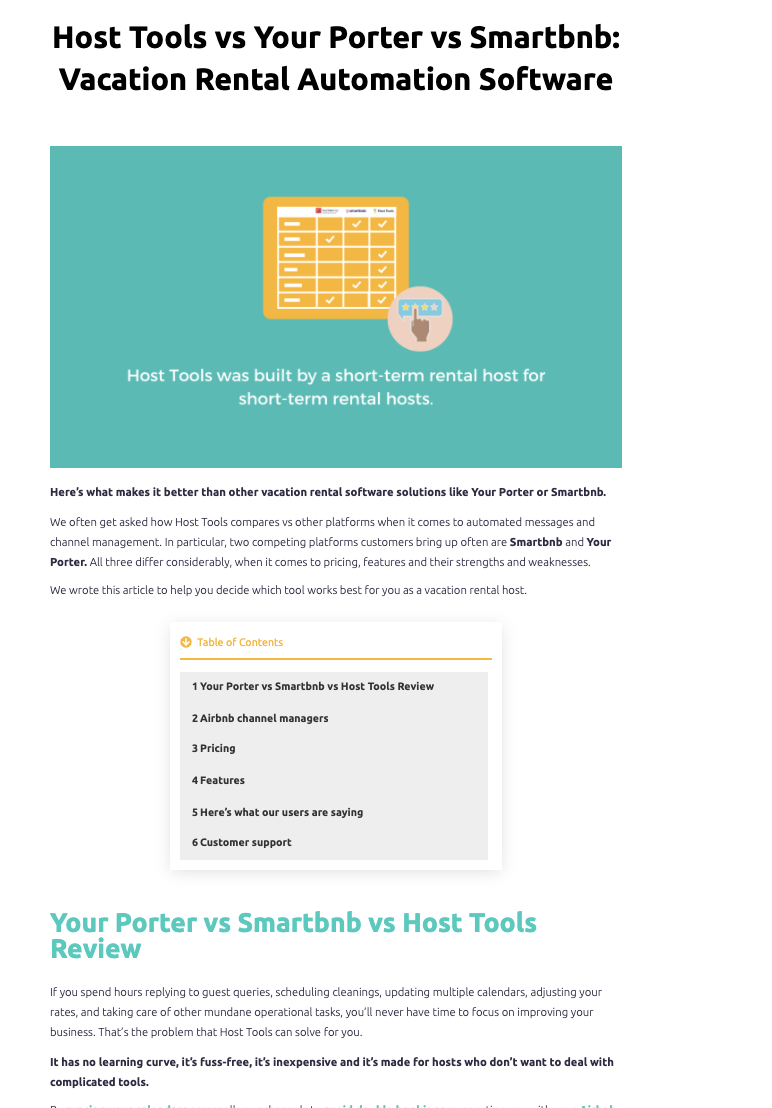

Host Tools is one of our clients, and we found that there were far more searches for their competitors than their own brand. So we piggybacked on their competitor’s traffic. If you search for “Your Porter vs Smartbnb”, you’ll find this article that introduces Host Tools to highly qualified readers who didn’t know about it yet.
Comparison keyword articles: best data cleaning tools
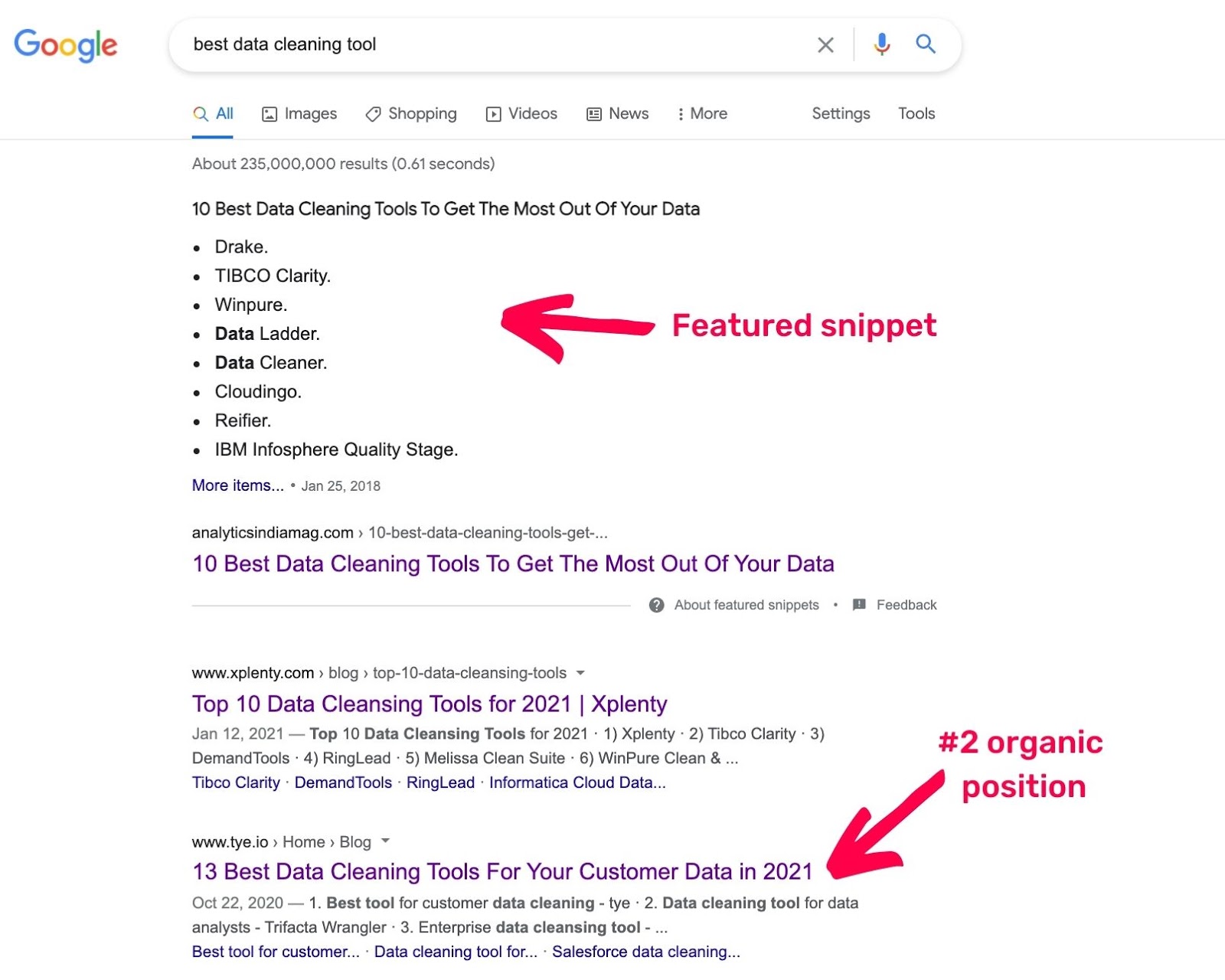

Another type of comparison keyword is “best X tools”. There are lots of different ways people might define what your tool is, and depending on how many features you have, you may be able to build a list for each. At the time of writing this, our client’s piece was only in position #2 for this keyword, but they’ll be number one soon
You can see the best data cleaning tools post here for inspiration.
Comparison keyword for a well-known brand: HubSpot vs Salesforce
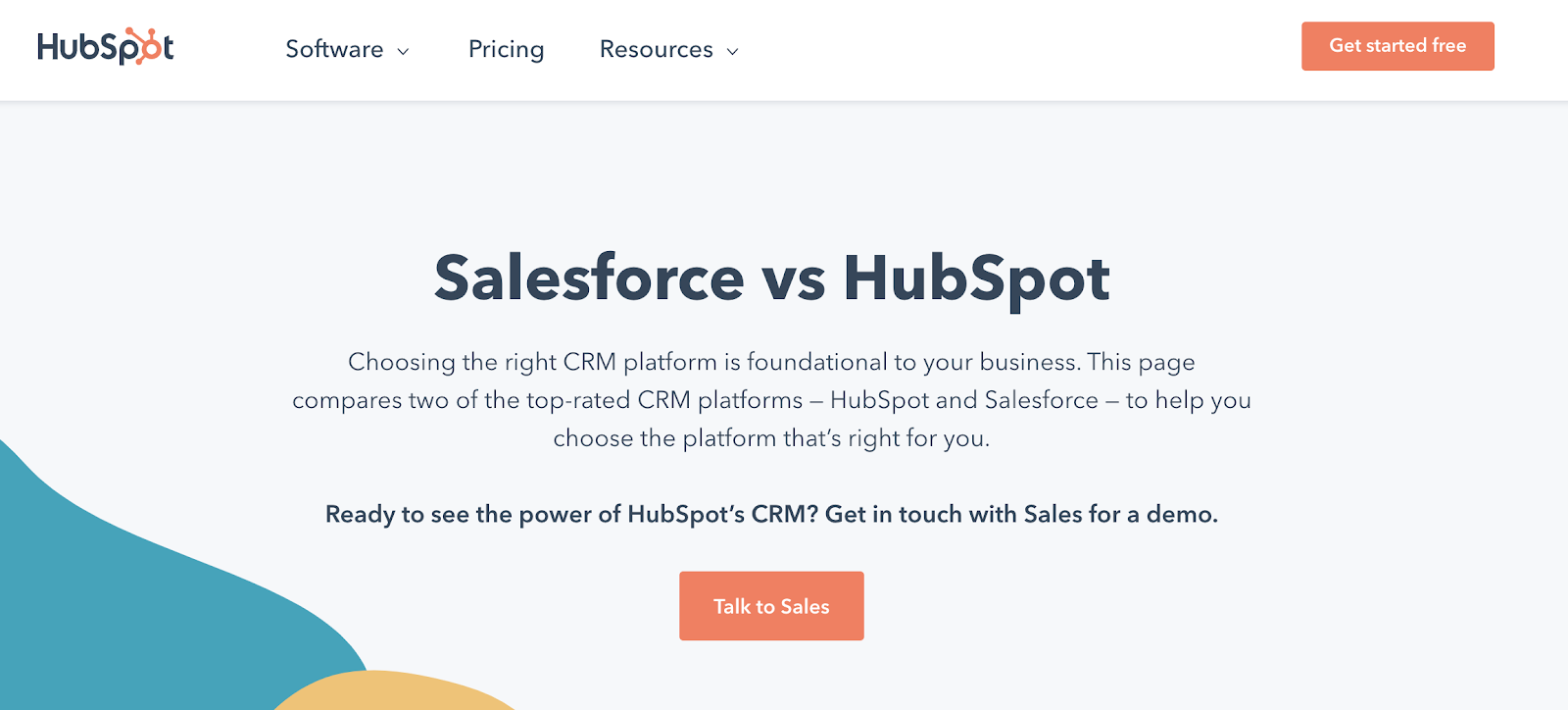

HubSpot’s comparison landing page is done just right: it covers all the aspects of how they differ from Salesforce and even offers the reader an explanation for how easy it is to switch from one to the other.
Comparison keyword: “Alternatives to HubSpot”
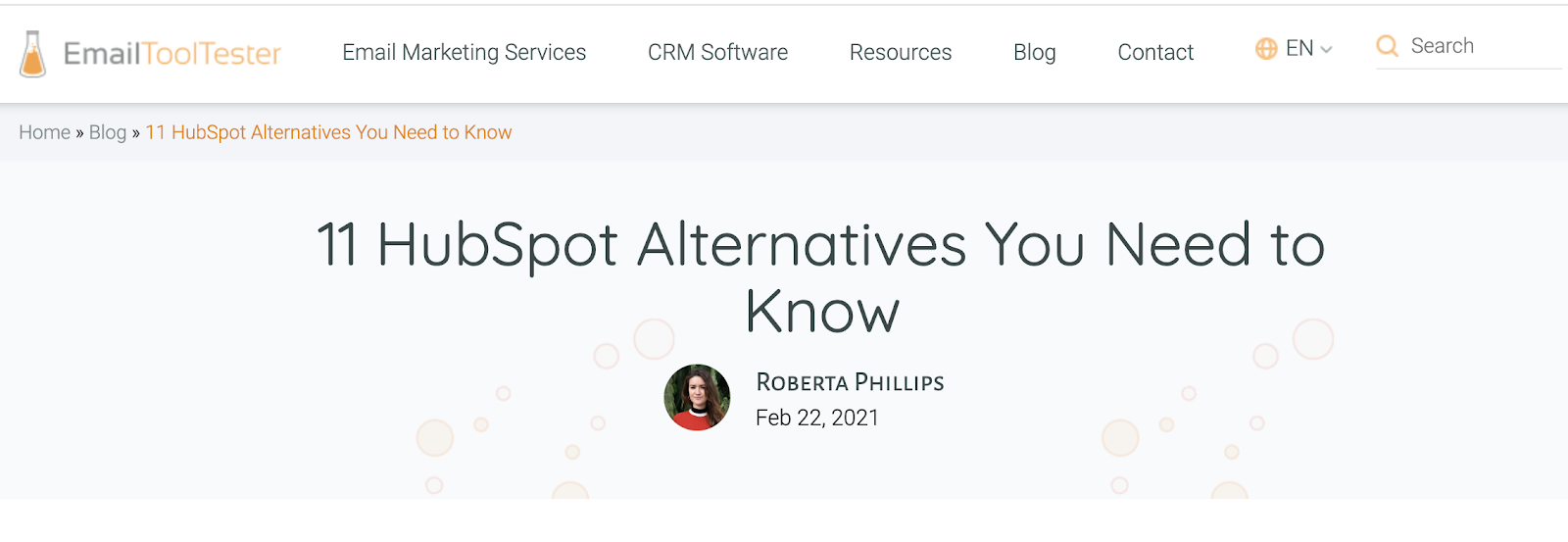

While a lot of the X vs Y posts can be done in a landing page, most “Alternative to X” posts will be in a blog-post format, usually as a listicle (listicile meaning there is a number at the start of the headline).
Sometimes you’ll find that you can compare your brand to your competitor and not list others. That works great for Adwords or PPC targeting your competitors’ keywords.
This HubSpot alternatives blog post ranks for the keyword “HubSpot alternatives”, which has 450 monthly search volume according to Ahrefs. But like I mentioned above, you won’t only be ranking for that one keyword. Look at the number of keywords that this page ranks for, nearly all in #1 position:
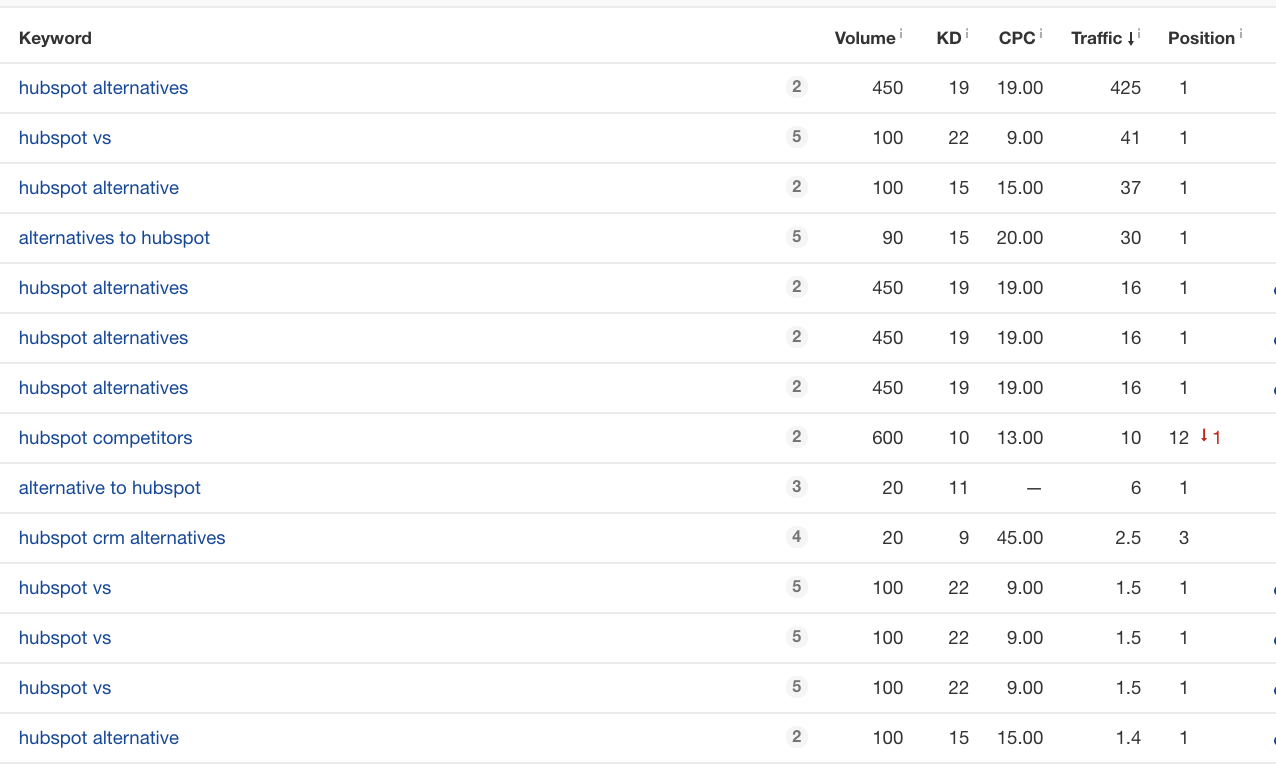

That’s a lot of cumulative search volume for the related keywords! These also work really well for Google Ads, even if you’re using organic keywords.
Writing your comparison keyword pages
Now that I hope I’ve convinced you to include these pages in your content strategy, it’s pretty straightforward on how to continue. You’ll have to build a list of all the potential combinations and competitors that you can create these pages for and then just go through the list one by one.
Depending on your goals, you might want to mix this up with other kinds of content to help grow traffic, build thought leadership assets, improve your brand image and interest your other readers.
Want us to do this for you? Book a free 30-minute marketing consultation today.
Join 1,798 other SaaS founders who are learning how to turn their websites into their #1 growth channel. Join the newsletter


